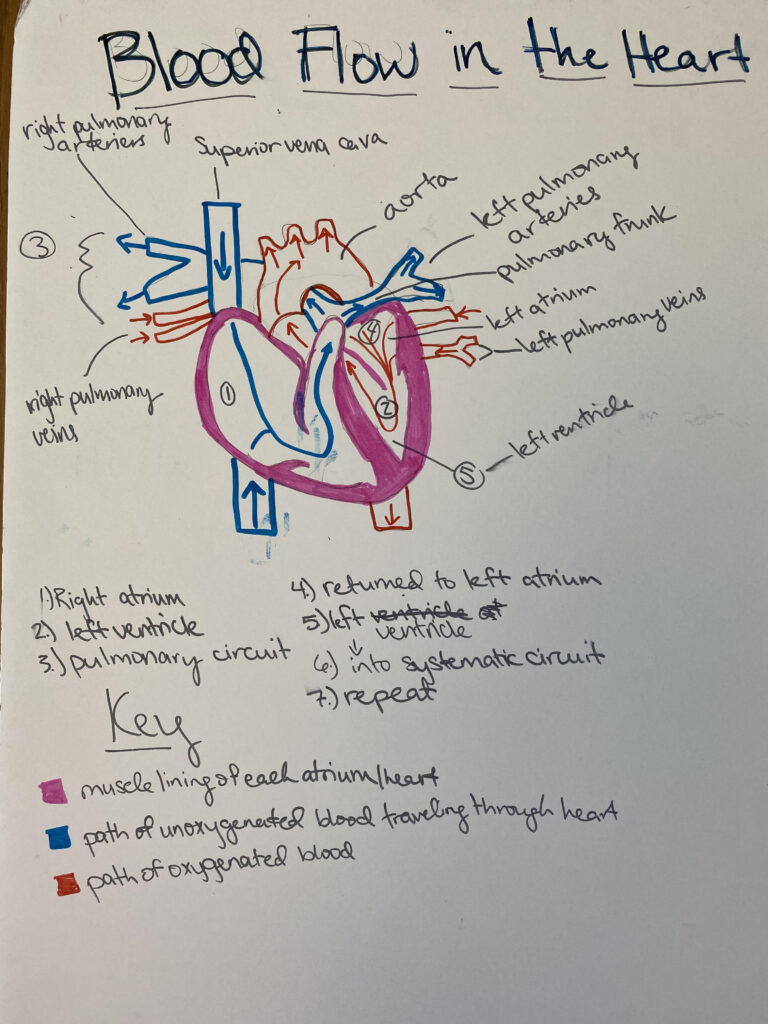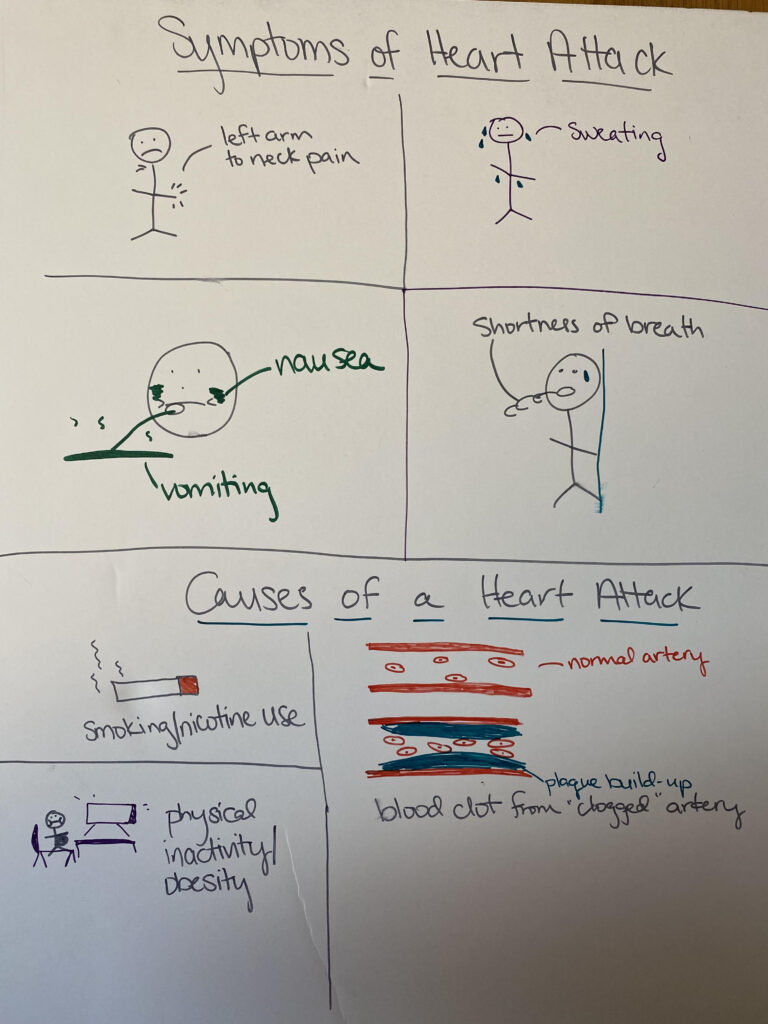The heart is one of the most important organs because it delivers oxygenated blood to the rest of the body, and when blood flow is blocked or inhibited to the heart, that can lead to heart failure. A heart attack is when one or more of the coronary arteries becomes blocked, thus stopping the flow of blood to the heart. The coronary arteries supply blood to the myocardium and other components of the heart, the first part of the aorta after the left ventricle leads to the coronary arteries. The left and right coronary arteries are branching out of two of the three dilations in the wall of the aorta: the left posterior aortic sinus and anterior aortic sinus. The path blood normally flows is as follows: from the right atrium to the right ventricle, then pumped into the pulmonary circuit, from the pulmonary artery, since the blood is low in oxygen, but high in carbon dioxide, gas exchange occurs in the pulmonary capillaries and the blood that is high in oxygen and lower in carbon dioxide is then returned to the left atrium. Continuing, blood will enter the left ventricle, where it pumps it into the systematic circuit, then after the exchange in the systemic capillaries where oxygen and nutrients out of the capillaries and carbon dioxide and wastes go in, the blood returns to the right atrium and the cycle is repeated again.
Heart disease is the number one killer in the United States, where about 34% of women and 44% of men die of a cardiovascular disease. A heart attack or, myocardial infarction, can happen to anyone. However, most of the time there are underlying factors that contribute to the failure of the heart. The Centers for Disease Control and Prevention states there are more common factors that can lead to a person’s heart failure: diabetes, if they are overweight, unhealthy diet, physical inactivity, and alcohol abuse. (CDC 2020). Smoking and nicotine use can also lead to a heart attack. These can lead to plaque building up in the walls of the arteries, causing the arteries, or pathway for blood to narrow, which in turn causes the heart to work harder trying to pump blood through the narrowing arteries. When a blockage happens, it is usually because of the plaque that has built up on the walls of the arteries ruptures, which then forms a clot in the artery, restricting blood flow to the heart. Then starts the heart attack, there are certain symptoms to look for to know when to call an ambulance: chest pain that reaches from the left arm to the neck, pain in the back/shoulders, shortness of breath, sweating, nausea, vomiting, abnormal heart beating, anxiety, fatigue, weakness, stress, depression, and sometimes other factors depending on female or male. To help treat these symptoms right away, taking an aspirin and calling emergency services is vital to the preservation of the heart.
In conclusion, in relation to the cardiovascular system, a myocardial infarction or a heart attack will disrupt the normal flow of blood in the heart, which can lead to many complications. Fortunately, there are many ways to prevent a heart attack, such as eating a healthy diet, regular physical activity, and annual check ups with an established physician to ensure optimal health.
References
Centers for Disease Control and Prevention. National Center for Chronic Disease Prevention and Health Promotion. (2020, September 08). Heart Disease Facts. Retrieved July 22, 2021, from https://www.cdc.gov/heartdisease/facts.htm
Clinic, Cleveland. (2019, July 19). Heart Attack (Myocardial Infarction). Retrieved July 22, 2021, from https://my.clevelandclinic.org/health/diseases/16818-heart-attack-myocardial-infarction
Betts, J. G., Desaix, P., Johnson, E., Johnson, J. E., Korol, O., Kruse, D., . . . Young, K. A. (2017). Anatomy & physiology. Houston, TX: OpenStax College, Rice University.
Lu L, Liu M, Sun R, Zheng Y, Zhang P. Myocardial Infarction: Symptoms and Treatments. Cell Biochem Biophys. 2015 Jul;72(3):865-7. doi: 10.1007/s12013-015-0553-4. PMID: 25638347.
Omran S, Al-Hassan M. Gender differences in signs and symptoms presentation and treatment of Jordanian myocardial infarction patients. Int J Nurs Pract. 2006 Aug;12(4):198-204. doi: 10.1111/j.1440-172X.2006.00572.x. PMID: 16834580.
For my project I illustrated the symptoms of a heart attack, as well as causes of a heart attack in relation to the cardiovascular unit. I also mapped out the path blood takes when going through the heart. As reference to what a normal path for a heart that does not have problems, I also illustrated how blood ideally flows throughout the heart.



Emily used drawing to depict how blood through our bodies. Not only that, but she included cartoons to show symptoms and causes of a heart attack. Emily described in depth the pathway of the blood flow, to quickly sum up her description: blood flows from the right atrium to the right ventricle ,pumped into the pulmonary circuit, from the pulmonary artery, gas exchange occurs in the pulmonary capillaries and the blood that is high in oxygen and lower in carbon dioxide is then returned to the left atrium. Blood enters the left ventricle, pumps it into the systematic circuit, then after the exchange in the systemic capillaries, the blood returns to the right atrium and the cycle is repeated again.
The way our blood flows is important, specifically, keeping it moving is key. Heart attacks, as stated above is the number one heart disease in the United States, which is one or more coronary arteries becoming clogged. In order to prevent heart attacks there are a few things you can do. Exercise, keep your body moving, don’t limited physical activity. Avoid smoking, cigarettes’ and nicotine. If you are experiencing a heart attack and don’t know it, look for the symptoms: left arm pain and pain starting from the chest, sweating, nausea and vomiting, and shortness of breath. If you notice any of these symptoms, as Emily stated: taking an aspirin and calling emergency services is vital to the preservation of the heart.